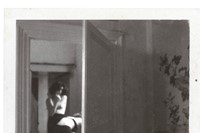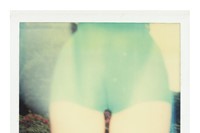A new show at Somerset House enters the sensual world of the photographic master Guy Bourdin
French photographer Guy Bourdin has been credited for bringing death, violence, and fetishism into the pages of Vogue. In Bourdin’s photographs, Surrealism à la his friend and mentor Man Ray is fused with flawless finishes, and brought into a post-war consumerist context. Ever since the BBC broadcasted the documentary Dreamgirls: The Photographs of Guy Bourdin in 1991, and the Victoria & Albert Museum hosted a first retrospective exhibition in 2003, Bourdin’s impact on visual culture seems to have increased. Today, his fan base ranges from François Nars to Vivian Sassen and beyond. One of them is fashion historian Alistair O’Neill, who has curated Somerset House’s new exhibition Guy Bourdin: Image Maker – the largest UK exhibition of the photographer’s work to date. AnOther sat down with Alistair on the first day of installing the show to discuss his highlights.
On my first encounter with Bourdin...
“I had a Vogue book on beauty photography and I was blown away by Guy Bourdin’s images. This was in the 80s, and I was very young at the time, but I knew Vogue didn’t look like that anymore. The photographs were amazingly exotic, luscious, and dense in saturation of colour. I was intrigued by the images and the period. Later I became fascinated with the stories around the photographs, and how people would talk about Bourdin.”

On the reappraisal of Bourdin...
“After Bourdin’s death, there was a lot of rumours circulating – about all the negatives being scratched or in very poor condition. This wasn’t entirely true, but of course, a desirable truth for good history writing. In the 1990s, there was a sense that Bourdin’s work needed to be reappraised. Unlike his contemporaries, Avedon and Newton, Bourdin wasn’t interested in developing a second career for his photographs by making them for galleries and monographs. But that is not to say that he didn’t want his work to last. He wanted them to inspire another generation.”
On the new exhibition...
“We are showing over 200 works – many of which have never been shown before – and a number of films and paintings, and his preparatory work, like Polaroids, sketches and notebooks, which will help establish Bourdin’s working process. There are many interesting parallels between the paintings and photographs. For example, some of the paintings have a shallow sense of pictorial depth, something you can also see in his photographs. The idea of the window as a portal into another kind of space, seems to be a motif for Bourdin. In one of the paintings, there is a toy plane crashing through a window. Now, there are sexual connotations to this with the plane depicted in close proximity to the model's buttocks, but the aeroplane is also a reoccurring motif for him, relating to his military training in Dakar in the 40s."
"Bourdin created impossible images in an analogue age"
On Bourdin and Surrealism...
“I always think that Bourdin is the only late 20th century photographer who took up the preoccupations of the Surrealist artists from the late 20s and early 30s, and transposed it into the 70s. In Bourdin’s case, it is because he was a protégé of Man Ray when he was trying to establish himself as an artist in the 1950s. This is evident in this series [of work shot in Britain] we are showing. It takes the mannequin as a prop in Surrealist photography, and makes a visual link back to that earlier approach.”

On Bourdin and models...
“It’s slightly unfortunate that people think of him as someone who looked down on models. He was interested in pushing the boundaries of the medium, and if that meant redoing shots and working hard, then sure. From 1977 to 80, Bourdin worked almost on an exclusive basis with Nicole Meyer. She understood that as a model she had to be willing to submit to what he wanted to produce. This particular Polaroid of Nicole shows her in a gymnastic, almost painful pose. It is not digitally alternated. The image is fantastically precise in the way it shows off the shoe design. But there is something about the body which is unnatural. It is like ballerinas on pointe. The body shouldn’t do that, but perhaps in that lies the beauty. One reason people are still fascinated with Bourdin is that he created impossible images in an analogue age. He didn’t rely on digital software and wasn’t really interested in using the older techniques for changing images or making fantastical images.”
On Bourdin and film...
“Bourdin used to take Super 8 films on sets. There are two types of films: the slow ones, and the rapid ones. They are produced in camera. We don’t actually know who is in this film. But I think it is interesting because there’s a direct engagement between model and photographer. The model is aware of her sexual charge and she is aware of how she can use her face and her body to convey a certain kind of attitude. She returns the gaze. If you look at a lot of contemporary fashion films, they struggle with this kind of directness and the ability to convey that attitude within the space of a minute. Bourdin’s films are proto-fashion films, really.”
Guy Bourdin: Image Maker is at Somerset House until March 15.
Words by Johan Deurell


